
Photo from wikipedia
Abstract Sodium p-styrene sulfonate (SSS) was successfully grafted on the surface of 316 stainless steel surfaces (SS-SCA-SSS) via Thiol-ene click reactions with the aim to improve its antibacterial properties. Fourier… Click to show full abstract
Abstract Sodium p-styrene sulfonate (SSS) was successfully grafted on the surface of 316 stainless steel surfaces (SS-SCA-SSS) via Thiol-ene click reactions with the aim to improve its antibacterial properties. Fourier transform infrared spectroscopy (FT-IR), X-ray photoelectron spectroscopy (XPS), laser scanning confocal microscopy (LSM) and contact angle measurements were employed to analyze physico-chemical characteristics of the modified SS. The antibacterial properties of SS-SCA-SSS was evaluated using a bacterial strain of Escherichia coli (E. coli). The antibacterial efficiency results showed that the SS-SCA-SSS surface exhibited satisfactory long-term antibacterial capability against E. coli. Bacterial adhesion of both SS-SCA-SSS and reused SS-SCA-SSS was reduced to 18% of those on SS. The positive results obtained in this study indicate the high potential of SSS grafting on SS surfaces for practical usages.
Journal Title: Materials Chemistry and Physics
Year Published: 2021
Link to full text (if available)
Share on Social Media: Sign Up to like & get
recommendations!